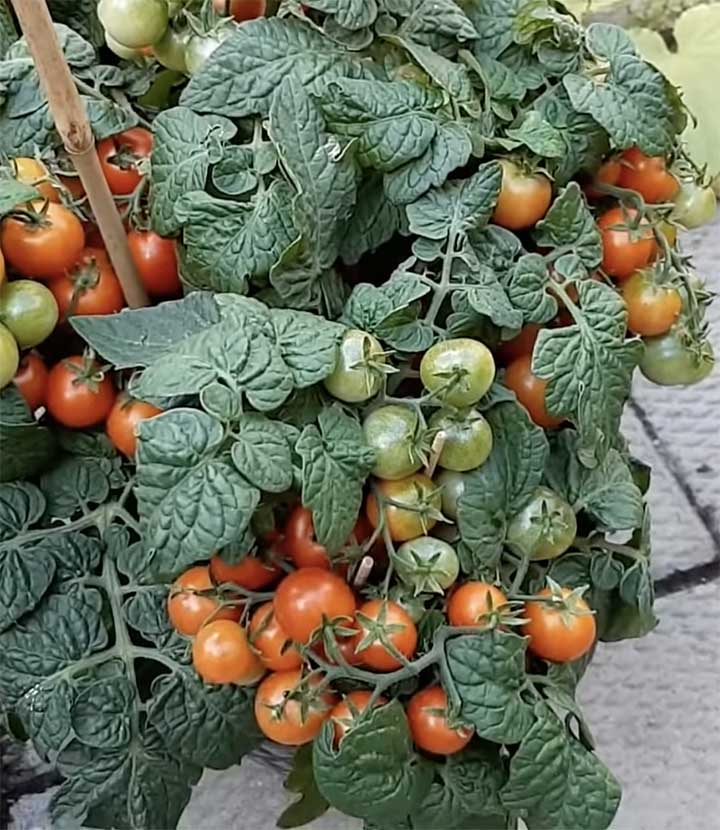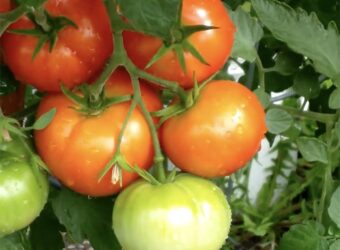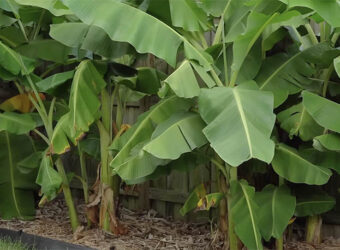Tomato plants typically require at least a few square feet of garden space or at least a sizable pot on a patio. However, if you’re dealing with limited space, you can still grow tomatoes!
Tiny Tim tomato plants max out around a foot tall, which makes them perfect for small patios, tabletops, and window boxes. And they’re not just for looks—they also produce many handfuls of red cherry tomatoes!
Interested in growing some Tiny Tim plants at home? Then stick with us as we cover all you need to know about growing Tiny Tim tomatoes.
Tiny Tim Tomato – Quick Growing Guide
| Plant Type: | Annual vegetable | Tolerance: | Alternaria Stem Cancer, Stemphylium |
| USDA Hardiness Zone: | 4–9 | Maintenance: | Low to moderate |
| Season: | Summer and early fall | Soil Type: | Rich and well-aerated |
| Exposure: | Full sun | Soil pH: | 6.2 to 6.8 |
| Time to Maturity: | 45–60 days from transplant | Soil Drainage: | Well-draining |
| Spacing: | 18-24 inches | Companion Planting: | Lettuce, sweet alyssum, basil |
| Planting Depth: | 1/4 inch | Avoid Planting With: | Potatoes, peas, pole beans, corn |
| Height: | 12-15 inches | Family: | Solanaceae |
| Spread: | 12 inches | Genus: | Solanum |
| Water Needs: | Moderate | Species: | lycopersicum |
| Common Pests and Diseases: | Aphids, thrips | Cultivar: | Tiny Tim |
What Are Tiny Tim Tomatoes?
Tiny Tim is a dwarf, determinate variety of tomato and is one of my favorite cherry tomato varieties. It is an heirloom and open-pollinated variety.
The plants max out at 12–15 inches tall and produce small red cherry tomatoes.
The Tiny Tim variety was first introduced in 1945 by the University of New Hampshire. It has remained a popular dwarf variety ever since.
These plants are quick to mature and begin producing ripe tomatoes just 45–60 days after they are transplanted. That makes them a great choice if you live in an area with a short growing season or got a late start on your garden.
What Do Tiny Tim Tomatoes Taste Like?
The plants produce handfuls of small red cherry tomatoes that are about an inch in diameter. While the fruits have a hint of sweetness, they are more on the acidic side.
Tiny Tim tomatoes are juicy and provide a satisfying explosion of tomato juice when you bite down on them. However, this variety is better known for its small plant size rather than its delicious tomato taste.
Where to Buy Tiny Tim Tomatoes
You may be able to find Tiny Tim seedlings at garden centers, plant nurseries, and big box stores in the spring. Since these plants are often grown in pots, you might even be able to buy them in a larger pot to avoid the work of transplanting them.
You can also purchase Tiny Tim seeds and start your own plants. Seed companies including Totally Tomatoes, Eden Brothers, and West Coast Seeds carry Tiny Tim seeds.
Starting Tiny Tim Tomatoes from Seed
Starting seeds is a great way to watch your tomatoes grow through their whole life cycle. It may also be necessary if you can’t find Tiny Tim seedlings near you.
First, you’ll need to determine when to start the seeds. Tiny Tim plants will be ready for transplant about 6–8 weeks after you plant the seeds.
So if you want the seedlings to be ready to transplant in the beginning of May, you should start seeds in the beginning or middle of March.
Unless you have a heated greenhouse, you’ll want to start your seeds indoors. This will ensure the plants can thrive even when outdoor temperatures are cold.
Since indoor space is often limited, I like to start my tomato seeds in small containers and then transplant them into larger pots. I find that 72 cell trays allow me to fit a lot of plants in a small area yet also provide enough soil to support the tomato plants over multiple weeks.
After you’ve obtained the containers you’ll start your seeds in, it’s time to choose an appropriate seed starting mix. I’ve used Vermont Compost Fort Vee and Coast of Maine Sprout Island Blend in the past with success.
Dump some potting soil into a large tub and add enough water so the mix is just slightly moist. Fill the containers so the soil is firm yet not compacted.
Use your finger to make a ¼ inch indent in each container/cell. Place one seed, cover it with a bit of soil, then water the seeds well.
Tomato seeds germinate best at temperatures between 65–85ºF, so you must place them in a warm area. If your home is on the cooler side, you can use a seedling heat mat to speed up germination. The seeds should germinate in 5–10 days.
Once the seeds have sprouted, they will need lots of bright light. An area near an extremely bright window can work, but I find that grow lights are the best way to ensure that indoor seedlings are receiving enough light.
Hang the lights just a few inches above the top of the seedlings and adjust them as the plants grow.
If you notice the seedlings’ roots pushing out of their containers’ bottoms, it’s time to bump them up into larger pots. When the seedlings are about a foot tall, you can transplant them into their final home.
How to Plant Tiny Tim Tomatoes
Due to their small size, Tiny Tim tomatoes can be planted in containers or in the ground. Here’s information about both of these methods.
Planting Tiny Tim Tomatoes in Containers
Potted Tiny Tim plants can be grown both indoors and outdoors. You can also start potted plants indoors and then move them outdoors once the weather has warmed.
You should select a container that is large enough to hold the plant’s roots but not so big that the soil takes a long time to dry. Generally, a container that is 10–18 inches deep is a good choice. And make sure the pot you choose has drainage holes!
Some suitable containers for Tiny Tim plants include this simple round pot and these window boxes.
If you choose to grow your Tiny Tim plants in containers, you must use a proper
soil mix. Look for a mix that drains well, holds a bit of water, and is rich in organic matter.
Some suitable options include Coast of Maine Tomato and Vegetable Planting Soil and Fox Farm Ocean Forest Potting Soil Mix.
Fill the container half full with potting mix then add your Tiny Tim plant. Add additional soil and loosely pack it around the plant’s root ball.
Planting Tiny Tim Tomatoes in the Ground
While many people opt to grow these small tomato plants in pots, you can also plant them directly in the ground. Their small size means you can fit plants in a small garden, but it also means you’ll need to bend over to tend to the plants and harvest the fruits.
Before you plant, ensure the soil is well-draining and not compacted. If it appears compacted, you can loosen it with a digging fork.
When you are laying out your garden, provide your Tiny Tim plants with at least a foot of space between plants.
Dig a hole that is a bit larger than the plant’s root ball then add a bit of compost. Place the seedling in the hole and fill the empty space with soil.
Caring for Tiny Tim Tomatoes
Caring for Tiny Tim tomatoes is much like caring for other types of cherry tomatoes. However, the plant’s small size makes its care a little bit different from other tomato varieties.
Temperature
Like all tomatoes, Tiny Tim plants are not cold tolerant.
If the plants are exposed to freezing temperatures, they will die. And extended periods below 50ºF can limit their growth and cause stress.
If you are transplanting your Tiny Tim plants outdoors, wait until nighttime temperatures are consistently above 50ºF.
Watering
Tiny Tim plants like soil that is consistently moist but not wet. This applies to both plants grown in pots and those grown in the ground.
Since Tiny Tim plants are smaller than other types of tomatoes, they won’t require as much water as other tomatoes. Typically, they will need about an inch of water each week.
However, it’s important to note that numerous factors impact the amount you will need to water. These include temperature, humidity, sunlight, soil type, and rainfall.
When it comes to potted plants, aim to water when the top two inches of soil are dry. Outdoors plants should be watered about three times a week, assuming no rain has fallen.
Avoid getting water on the plant’s leaves, as this can encourage the development of fungal diseases.
Fertilizing
Although Tiny Tim plants are small, they will still benefit from regular fertilization!
When the plants are in their vegetative growth stage, fertilize once every two weeks with a high-nitrogen fertilizer. Make sure that you dilute the fertilizer following product instructions before you apply it to your plants.
Once the plants are a foot tall, you should switch over to a fertilizer that is higher in potassium and phosphorus and lower in nitrogen. This will help promote and support the development of fruit and flowers.
Two good options for flowering fertilizers include Espoma Organic Tomato-Tone and Jobe’s Organics Vegetable and Tomato.
Providing Support
Since Tiny Tim plants are so small, you don’t need to stake or trellis them. Typically, the plants can support themselves without falling over.
However, you can insert a small bamboo or wooden stake and then tie the plant to the stake for support.
Managing Pests and Diseases
If you are growing your Tiny Tim plants indoors, they will be less susceptible to many of the fungal diseases that impact outdoor plants. However, you should still keep an eye out for common pests such as aphids and thrips.
Outdoor plants will be susceptible to pests as well as diseases like septoria leaf spot, early blight, and powdery mildew.
In general, low humidity and good airflow will limit the development of diseases. Maintaining healthy plants will also help the plants fight off pests and diseases.
If you do spot anything wrong with your Tiny Tim plant, try to identify and remedy the issues as quickly as possible.
Harvesting Tiny Tim Tomatoes
Since Tiny Tim plants are quite small, it’s easy to see when the fruits are ready for harvest! You can expect to pick your first ripe tomato anywhere from 45–60 days after you transplant them in the ground.
When Tiny Tim tomatoes first form, they will be light green. They will remain green until they reach their full size.
As the tomatoes begin to ripen, they will turn yellow, light orange, and eventually red. You should wait to harvest the tomatoes until they are deep red.
Since Tiny Tim plants have a determinate growth form, all of their tomatoes will ripen over the course of a month. It’s a good idea to harvest every few days during this time.
Storing Tiny Tim Tomatoes
While Tiny Tim plants are small, they can produce quite an impressive amount of tomatoes for a plant their size! Therefore, you may not be able to eat all the tomatoes as soon as you harvest them.
You should store your tomatoes in a cool (50-65ºF) place out of direct light. However, avoid placing the fruits in the refrigerator since this can lead to a chilling injury.
As long as they’re stored under the proper conditions, ripe Tiny Tim tomatoes should remain good for about 3–5 days.
How to Use Tiny Tim Tomatoes
The red cherry tomatoes that Tiny Tim plants produce can be used in a variety of ways.
Of course, you can pop the tomatoes right in your mouth for a healthy and refreshing snack. You can also add them to salads, chop them for salsa, or roast them in the oven for soups and stews.
If you end up with more tomatoes that you can use, you can freeze them for later use. Spread the tomatoes on a baking sheet, pop them in the freezer, then transfer the fruits to a plastic freezer bag once frozen.






